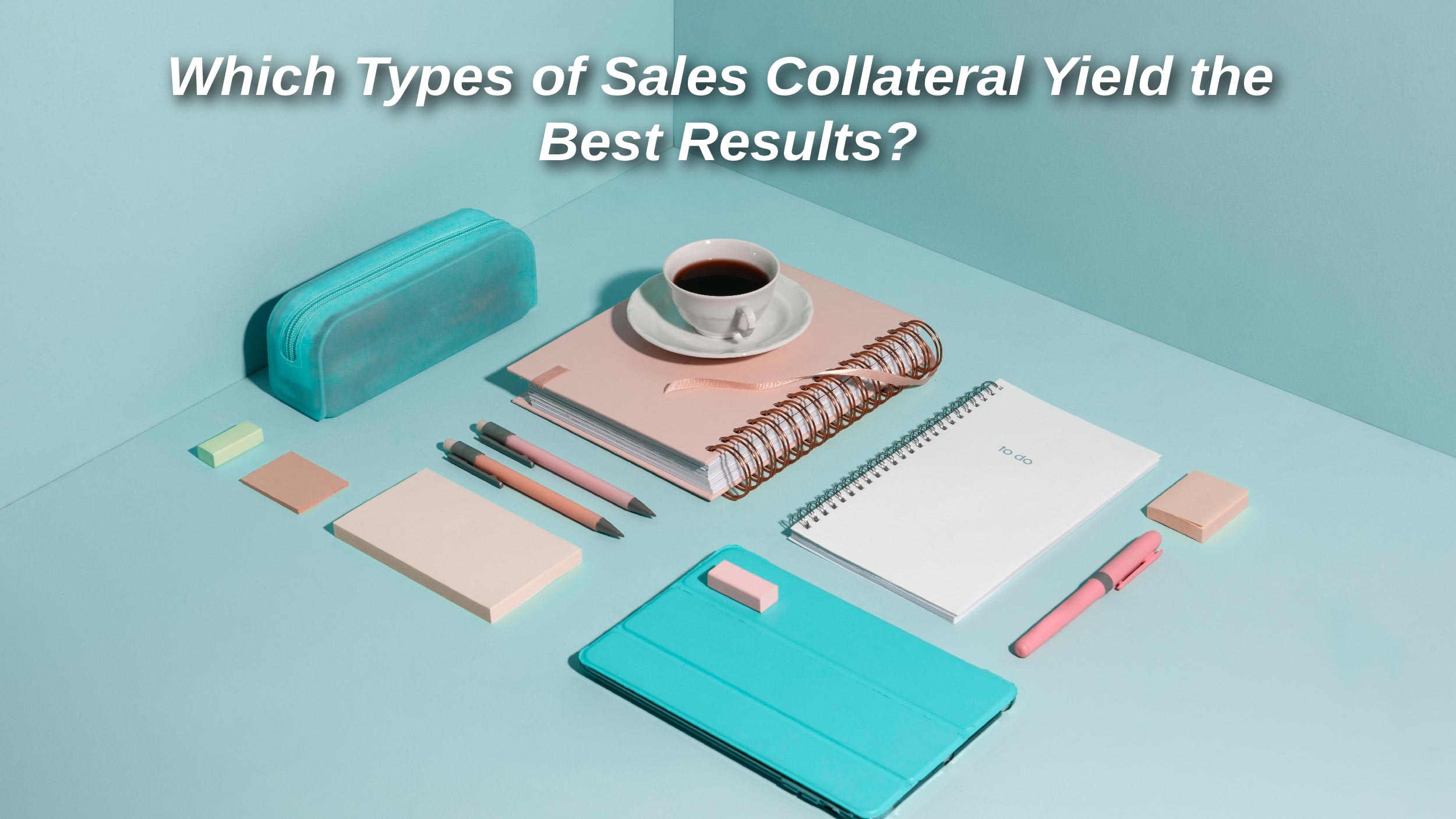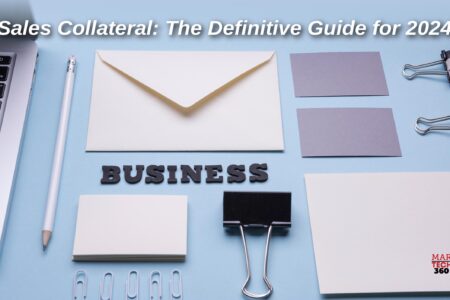Imagine this, your sales team is doing everything in their power but is just not able to hit the scale you want.
This might be due to a lack of proper sales collateral content. Now before you think about the billion-dollar question, let’s break down its meaning.
Effective sales collateral management serves as the perfect companion to your sales process. Instead of lengthy phone calls, an elegant eBook or guide can summarize complex information for leads. Utilizing digital reports or blogs showcases your brand as a thought leader.
When a lead is grappling with product understanding, timely video guides can be the game-changer, influencing their decision in your favor.
Let’s dig deeper.
What is Sales Collateral?
Sales collateral consists of a myriad of documents and media crucial for guiding leads through the sales funnel. This encompasses a wide range of traditional printed materials like adverts flyers and brochures as well as an array of digital assets such as blogs landing pages eBooks videos and social media posts. 88% of salespeople utilizing sales enablement content in their roles consider it moderately to extremely important in closing a sale.
Which Types of Sales Collateral Yield the Best Results?

Today’s content producers have access to an array of captivating and inspiring content formats to captivate potential customers.
Interactive forms and immersive user experiences, such as parallax scrolls and background videos, have the power to breathe life into your collateral and stand out from the competition.
If the thought of implementing these advanced content formats seems daunting due to budget constraints or lack of internal expertise, fear not. With the appropriate tools and a bit of training, you can quickly master these techniques. If you’re seeking an intuitive solution for simplifying the production of sales collateral, consider exploring our content creation platform. It could be the perfect resource for elevating your content and driving more conversions.
How Do You Make Sales Collateral?
To create effective sales collateral, begin by understanding your target audience’s needs and stage in the journey. Tailor content with diverse formats such as case studies, sales guides, product demos, interactive forms, and videos.
Measure effectiveness through analytics and collaborate with the sales team to align collateral with their needs. Centralize access via a content management system for easy availability, and track usage to enhance buyer engagement.
How To Organise Sales Collateral?
- Evaluate and Align with Goals: Begin by assessing your existing collateral library. Ensure each piece aligns with your organization’s goals and objectives. Identify any gaps or missing types of collateral needed for comprehensive coverage.
- Categorize According to Buyer’s Journey: Organize your collateral based on the stages of the buyer’s journey. Tailor content for awareness with blogs, eBooks, landing pages, webinars, and social media content. This ensures that the right information reaches potential customers at the right time.
- Prioritize Formatting and Calls-to-Action: Practical formatting and clear calls-to-action are essential elements of effective collateral. Ensure that the content is user-friendly, visually appealing, and prompts the desired action from the audience.
- Align with Buyer’s Journey: Aligning collateral with the buyer’s journey effectively engages potential customers. It guides them through the decision-making process and nurtures long-term relationships. Tailoring content to each stage ensures relevance and resonates with the audience’s specific needs.
- Enable Sellers and Track Usage: Consider enabling sellers to easily access, learn about, and utilize the content. Implement tracking mechanisms to monitor the use and effectiveness of collateral in engaging buyers. This data helps in refining strategies and optimizing content for continuous improvement.
By following these steps and embracing best practices, you can systematically organize and optimize your sales collateral, ultimately maximizing its impact on your target audience.
Also Read: What is Content Engagement? A Comprehensive Guide with Proven Strategies
What Is The Difference Between Marketing Collateral And Sales Collateral?
Given below is the basic difference:
| Aspect | Marketing Collateral | Sales Collateral |
| Purpose | Build brand awareness and attract potential customers. | Close deals and convince prospects to make a purchase. |
| Focus | Broad, targeting a wide audience. | Specific, tailored to individual prospects or deals. |
| Content Types | Brochures, social media content, blog posts, infographics. | Product sheets, case studies, presentations, demos. |
| Timing | Often created before direct interaction with prospects. | Utilized during direct interactions with potential customers. |
| Goal | Educate, inform, and create interest in the brand. | Persuade and provide information to encourage a purchase. |
| Distribution | More widely distributed through various channels. | Shared directly with leads during sales conversations. |
| Longevity | May have a longer shelf life as part of brand messaging. | Tailored to immediate sales efforts, may be short-lived. |
| Examples | Social media posts, whitepapers, brand videos. | Product brochures, sales presentations, and client testimonials. |
5 Ways to Create an Amazing Sales Collateral
If you’re new to producing collaterals or someone who already knows the process, it’s always refreshing to keep updated on the new process.
It’s important to take a step back and ensure that your sales content is as effective as possible because technology, consumer expectations, and available content formats are constantly changing.
Review and Revamp Your Sales Collateral Strategy
Whether you’re a seasoned pro or new to creating collateral sales, periodic reviews are crucial. Examine the formats, messages, tools, and designs you employ. Given the evolving needs of customers and technological advancements, a regular reassessment ensures the continued effectiveness of your collateral.
Identify Customer Needs and Tailor Content
Collateral content must be customer-centric, aligning with their evolving needs throughout the buyer journey. Engage with your audience, understanding their requirements at different stages. Feedback from your current customer base is invaluable; inquire about what sets your brand apart and why they remain loyal. This interaction can also yield testimonials and case studies.
Recycle and Repurpose Marketing Content
Classic formats can be modernized for enhanced engagement and scalability. Recognize that marketing content is also sales content. Leverage blogs, eBooks, social media posts, and more, designed for your specific audience. Analyze website metrics, email campaign results, and other marketing data to identify popular content. Foster collaboration with content creators to harness their insights and effectively repurpose existing material.
Maintain Brand Consistency
Brand consistency is paramount for successful sales and marketing. Every customer touchpoint should exude recognizability, credibility, and impeccable production. Develop a style guide, customer personas, and a tone of voice guide to ensure that your collateral consistently reflects your brand, especially when multiple contributors are involved.
Utilize the Right Tools for Streamlined Production
Efficient production of high-quality sales collateral necessitates the right tools. From ideation to distribution, employing tools that streamline processes is essential. Creating bespoke content tailored to specific interests or pain points enhances lead generation and conversions.
Content creation platforms like Foleon simplify sales enablement, allowing for the creation of rich, immersive formats without internal design expertise. The ability to bring quality content to market swiftly reduces bottlenecks in the sales process, maintaining customer interest throughout the buyer journey.
The engagement data provided by the platform enables continuous improvement of campaigns and customer journeys over time.
Final Takeaway
As we conclude our guide, we trust you now feel more assured about the types of content that can contribute to the growth of your business and boost conversions.
The key is to provide your potential customers with personalized collateral that distinguishes itself. Given that your sales team often has mere seconds to make an impression, equipping them with compelling, interactive, valuable, and pertinent sales collateral at the right moment can be a game-changer.

